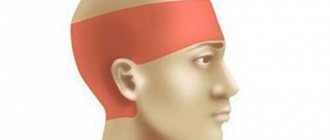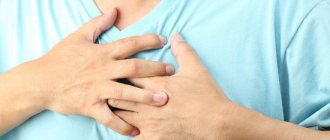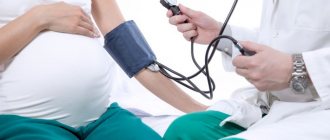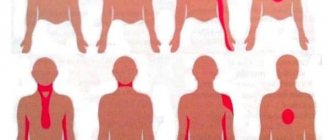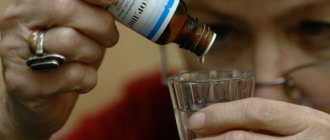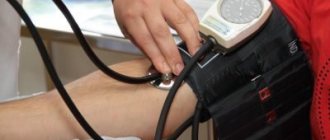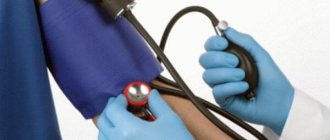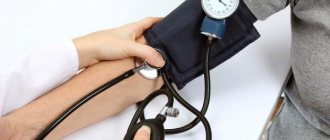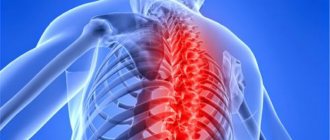Causes of pain
Pancreatitis
Inflammation of the pancreas is the most common factor causing pain on the left side under the ribs. A number of reasons can cause inflammation of an organ:
injuries of the upper floor of the abdominal cavity;
Helicobacter pylori infection;
complications after operations and manipulations (endoscopy).
An attack of pancreatitis is characterized by severe pain under the left rib, radiating to the back and shoulder. Often people complain of a sharp girdling pain, combined with uncontrollable vomiting.
With chronic inflammation, the pain syndrome has a dull, aching character, intensifying against the background of physical activity, overeating, alcohol abuse or excessive consumption of fresh fruit. This form of the disease is a logical continuation of untreated acute pancreatitis.
Relief of pain in acute pancreatitis consists of therapy aimed at eliminating its cause - inflammation of the pancreas. In addition, for symptomatic purposes, analgesics are prescribed and novocaine blockades are carried out. The introduction of a local anesthetic to the organ bed in the acute phase of the inflammatory process significantly relieves its painful manifestations.
Intercostal neuralgia
Osteochondrosis, herniated intervertebral discs, and compression fractures of the vertebrae due to osteoporosis often serve as a trigger for sharp pain in the left hypochondrium. Unpleasant stabbing sensations begin behind the spine with a sudden attack. The mechanism of this pathology is compression of the intercostal nerves by the structures of the spinal column. Neuralgia can simulate some diseases of the abdominal organs. Its distinctive features:
sharp pain under the left rib behind, starting from the vertebrae;
the beginning is associated with a sudden movement;
the pain worsens when turning or simply bending the body;
may disappear when stationary;
there are no dyspeptic symptoms (nausea, vomiting, bloating, changes in stool character).
Another feature of the pain syndrome is its rapid relief after an injection of an anti-inflammatory drug (diclofenac, dicloberl) or a manual therapy session. In the absence of proper care and elimination of the cause, attacks of neuralgia recur periodically.
Peptic ulcer
Aching pain under the left rib in the front is provoked by a stomach or duodenal ulcer. It is localized below the xiphoid process or, popularly, “in the pit of the stomach.” There is a clear connection with food, thanks to which the presumptive localization of the ulcerative defect is established:
pain immediately after eating corresponds to an ulcer of the entrance (cardiac) section and body of the organ;
symptoms appear a few hours later with an ulcer of the exiting section;
night pain is predominant for a defect in the duodenal mucosa.
In addition, peptic ulcer disease is characterized by dyspeptic symptoms. Similar symptoms and aching pain under the left rib can also be observed with a diaphragmatic hernia. A distinctive feature of a hernia is early vomiting after eating, which brings relief. It is also characterized by a specific symptom - lying down immediately after eating causes regurgitation of gastric juice into the esophagus, manifested by an unbearable sour taste in the mouth.
The pain of a peptic ulcer disappears or is significantly reduced by diet and taking medications that reduce acidity.
Injury
The lateral walls of the abdomen and chest are rich in nerve endings, which, if traumatically damaged, cause pain. After a rib fracture, it persists for several months. It is relieved after taking analgesics and local anti-inflammatory compresses.
The main danger of injury to the left costal arch is not considered to be a fracture of the ribs, but damage to the internal organs. The etiology of severe pain under the left rib may be a rupture of the spleen - a condition that threatens massive intra-abdominal hemorrhage.
When an organ ruptures, pain radiates to the lower abdominal wall, where blood flows, and the left shoulder, which is associated with irritation of the fibers of the phrenic nerve. There is also a specific sign for this injury. When a person tries to lie down, the pain in the abdomen and shoulder increases sharply, causing him to quickly get up. In the medical literature, this is called the “vanka-vstanka” symptom.
A splenic rupture is a serious condition that requires immediate surgical intervention. In most cases, the essence of the operation is the complete removal of an organ that no longer performs vital functions in adults. In extremely rare cases, when the patient’s condition is stable and the degree of organ destruction is insignificant, it is possible to perform organ-saving surgery.
Heart diseases
Dull pain under the left rib is a manifestation of angina pectoris and myocardial infarction, when delay and incorrect diagnosis have a poor prognosis. Treatment of pancreatitis, neuralgia or ulcers during an acute heart attack is worse than absolute inactivity. It is advisable to remember the symptoms accompanying the abdominal form of myocardial infarction:
numbness of the left hand;
For these symptoms, an electrocardiogram should be the leading diagnostic procedure, without which treatment cannot be started. Pain relief for a heart attack involves the administration of narcotic analgesics and the use of nitroglycerin tablets. If this diagnosis is suspected, an ambulance should be called immediately.
Pneumonia and pleurisy
Inflammation of the lung or pleura covering this organ is a potential cause of pain in the area of the left costal arch. The stabbing pain intensifies with deep inhalation and finger pressure on the intercostal spaces. These diseases occur against the background of a cold and, in addition to pain, are accompanied by a number of symptoms:
lag of the left half of the chest in the act of breathing;
smoothing of intercostal spaces.
Pain relief occurs virtually independently after the start of treatment for the underlying problem. For this purpose, antibacterial drugs, anti-inflammatory, antitussive and expectorant drugs are used. In cases of exudative pleurisy, when fluid accumulates in the pleural cavity, it may be necessary to perform puncture and aspiration of inflammatory exudate.
Colon diseases
On the left in the hypochondrium is the splenic angle of the colon. When it is inflamed, torsion, or a tumor, pain may occur in this area. It is often accompanied by some of the symptoms:
pathological impurities in feces (mucus, blood, pus);
diarrhea or constipation;
absence of gas and stool.
Delay in such a case threatens surgical intervention. Therefore, if you have such symptoms, you should immediately go to the hospital. Pain syndrome in pathology of the colon is rarely the leading symptom, so it quickly stops after eliminating the root cause of the disease.
Renal colic
Stones or sand in the urinary tract are a likely cause of obstruction of the flow of urine into the bladder from the kidneys. In such situations, increased pressure occurs in the pelvis of the latter, the tissue and capsule of the organ stretches, and severe pain occurs. Acute piercing pain is predominantly localized under the ribs at the back. Such an attack is accompanied by a disturbance in the nature of urination in the form of retention, frequent urge or bloody urine. Patients are always restless, it is difficult for them to find a place or a comfortable position in which the attack would not be so pronounced.
Emergency care for renal colic involves administering a combination of various anti-inflammatory, analgesic and antispasmodic drugs. More often than not, the pain subsides after this. To prevent a recurrent attack, it is recommended to take a hot bath, place a heating pad on the painful area, or drink a small amount of strong alcohol. These activities lead to relaxation of the smooth muscles of the urinary tract, the passage of small stones and sand. Subsequently, the patient needs a mandatory scheduled consultation with a urologist to determine the tactics for further treatment of urolithiasis.
Diagnosis of rib pain
If your left back hurts regularly under your ribs, you need to seek help as soon as possible. The reasons can be different - from bruises to stenosis and oncology. The nature of the back pain on the left under the ribs is the first indicator of the cause of the syndrome:
- girdling;
- shooting;
- aching;
- pulsating.
The pain syndrome can radiate to the right half of the back, neck, lower back, abdomen, and shoulder blade.
When your back hurts in the back left under the ribs, first of all you pay attention to the condition of the spine. Pain in back diseases can spread to the hypochondrium, arms, legs, depending on the affected area. The cause of back pain on the left under the ribs is pinched nerve roots and muscle spasm.
This happens with osteochondrosis and intervertebral hernias. Nature of pain:
- sharp lumbago;
- aching, deep pain in the left hypochondrium, which radiates to the back;
- the pain radiates to one leg, especially when walking.
If the cause of pain in the left hypochondrium, radiating to the back, is precisely the pathology of the spine, additional symptoms appear. This is muscle stiffness, a feeling of tingling, numbness, “goosebumps” on the skin at the site of the lesion. Tendon reflexes change, sensitivity to touch decreases.
Gastrointestinal diseases
Pain in the left hypochondrium from the back often accompanies diseases of the digestive tract. This syndrome can be caused by an inflamed pancreas. With exacerbation of inflammation - pancreatitis - the pain becomes encircling, affecting the opposite side.
Such pain in inflammatory pathologies of the intestines and stomach can be called atypical. But exacerbation of gastritis or ulcerative lesions can be expressed in this way, although more often the pain radiates to the right side.
Lung diseases
If there is pain on the left under the ribs from the back, you need to pay attention to the condition of the respiratory system. Such pain is caused by lower lobe pneumonia or pleurisy. If the cause is truly in the respiratory system, pain on the left under the ribs on the back side appears when inhaling or when coughing, which inevitably accompanies these conditions.
With a bilateral inflammatory process, the pain is girdling in nature. If you lie on your painful side or back, the discomfort becomes less.
The most common cause of pain in the left hypochondrium, radiating to the back, is heart and vascular disease, along with pathologies of the spine. Diseases that may be accompanied by such symptoms:
- cardiac ischemia;
- myocarditis;
- pericarditis;
- angina pectoris;
- myocardial infarction.
If a heart attack affects the posterior walls of the myocardium, pain from the back on the left under the ribs spreads to the left arm, shoulder blade, and can radiate to the jaw on the left. Angina pectoris is accompanied by the main focus of pain closer to the center of the chest region and back. The pain seems to penetrate right through not only from the back, but also in the chest.
To diagnose the causes of pain in the ribs on the left from the back, the following is prescribed:
- general blood and urine tests;
- Ultrasound of the abdominal organs;
- CT, MRI if there is a lack of information after ultrasound.
This is a general examination plan, it will also be prescribed for pathologies of the spine - this is enough to detect osteochondrosis, scoliosis, and hernia. If gastrointestinal pathologies are suspected, tests will be prescribed:
- stool for occult blood;
- blood glucose;
- amylase, C-peptide.
Ultrasound helps determine the condition of the pancreas. To evaluate the stomach and intestines, gastroduodenoscopy will be prescribed.
Photo from the site medinvest.zp.ua
For lung diseases, the doctor will prescribe a laboratory test of sputum discharge, as well as an x-ray or fluorography. For diseases of the heart and blood vessels, an analysis is prescribed for ALT and AST, myoglobin, electrolytes, C-reactive protein and lipid profile. A coagulogram and an electrocardiogram, including with exercise or daily, also provide sufficient data.
If pathology of the genitourinary system is suspected, the following will be prescribed:
- vaginal/urethral smear;
- bacterial culture of urine;
- urine examination for protein, density, epithelial particles;
- urine transparency test;
- daily diuresis.
Ultrasound with a contrast agent is also prescribed for diagnosis.
Pain under the left rib from the back is not a separate disease that requires treatment. This is only a symptom that can be temporarily relieved until the cause is determined.
Analgesics and non-steroidal anti-inflammatory drugs are used to relieve pain. Hormonal painkillers are indicated for acute, unbearable pain; they are prescribed only by a doctor, but you need to understand that such pain is a sign of an emergency condition, and it cannot be relieved until the ambulance arrives.
Analgesics and NSAIDs to eliminate pain in the left hypochondrium from the back of moderate intensity:
- Panadol.
- Ibuprofen.
- Meloxicam.
- Nimesulide.
- Diclofenac.
- Efferalgan.
Diclofenac is best used in the form of an ointment, locally in the affected area. All medications must first be discussed with a doctor, as they have a number of contraindications and restrictions, and in case of stomach pathologies they can greatly worsen the condition. That is why diagnosis comes first.
Pain under the ribs on the left side of the back is a symptom of many inflammatory diseases. The doctor determines the possible cause by the nature of the pain and accompanying symptoms, and laboratory and hardware diagnostics confirm or refute the diagnosis. The sooner the cause is identified, the sooner it will be eliminated and the pain will be relieved.
List of sources:
- Parfenov V. A., Isaykin A. I. Pain in the lower back: myths and realities / Neurology, neuropsychiatry, psychosomatics. – 2002.
- Gerasimova O. N., Parfenov V. A. Treatment of acute nonspecific back pain in outpatient practice / Neurology, neuropsychiatry, psychosomatics. – 2009.
- Mikhailov V.P., Stebnitskaya S.A., Polosukhin A.D. Back pain and attempts to objectify it / Spinal surgery. - No. 3. – 2009. – p. 64-70.
- Burmistrov D. A., Demin G. S., Makushenko I. E. Program for eliminating back pain in people of different ages / Scientific notes of St. Petersburg State Medical University named after. I.P. Pavlova. – 2010.
Purulent abscesses in the lung provoke a painful cough, pain and muscle tension
There may be several pathological causes of rib pain in an adult or child. In some cases, it is a consequence of a disease of the internal organs and has a reflected character; sometimes the root cause of the pain syndrome is precisely the pathology of the musculoskeletal system of the chest.
Pain when coughing
Cough is one of the most unpleasant symptoms of various acute respiratory viral infections (ARVI) and pneumonia. If it is acutely painful in the area of the rib bones, this causes additional suffering to the patient. Pain in the ribs when coughing is included in the symptoms of the following pathologies of the respiratory system:
- Pneumonia – causes pain in the ribs when breathing in or coughing. The pain syndrome in this case is a reflection of the inflammatory process. Since the lung is a paired organ, rib pain can be felt both on the right and on the left, depending on which side the inflammation has developed. If both lungs are affected, the entire chest hurts.
- Pleurisy is inflammation of the pleura (the outer lining of the lungs). When the disease becomes more complicated, fluid accumulates between the lung and pleural tissue, which is characterized by acute pain when coughing or inhaling or exhaling.
- Acute bronchitis. When the ribs hurt when coughing, this is explained by the irradiation of the pain syndrome that occurs as a result of excessive tension in the pectoral muscles with strong and prolonged cough spasms.
- Lung abscess. An abscess formed in the pulmonary cavity causes a person to cough, and every breath causes sharp pain in the chest and ribs.
- A neoplasm in the bronchopulmonary system - the tumor strongly compresses the respiratory organs, making it difficult to breathe and causing coughing attacks.
With inflammation of the mammary gland, the pain may spread to the rib and intensify when coughing or sneezing.
If the ribs in front hurt when coughing and pressing on the stomach, this may mean a pathological process in the abdominal organs. Pain in the center of the epigastric zone in the pit of the stomach is characteristic of diseases such as gastritis or stomach ulcers, gastroesophageal reflux disease, esophageal or diaphragmatic hernia.
Pain in the left side at the level of the third rib from below may be one of the symptoms of pancreatitis - inflammation of the pancreas. The right side responds with pain in the ribs in case of inflammation of the liver or gall bladder - cholecystitis, or in case of cholelithiasis, in which intestinal bloating is also observed. Pain when pressing on the lower ribs from the back can be a sign of kidney disease.
Also, pain in the middle of the chest when pressing or coughing is a symptom of cardiovascular pathologies - myocardial infarction, pericarditis, myocarditis. It can occur sharply and suddenly, preventing you from breathing freely, but sometimes it has an aching, vaguely defined character.
This symptom is most typical for certain types of damage to the bone and cartilage tissue of the skeleton in the chest area. This may include:
- Various types of rib injuries. When, after a fall or blow, swelling and hematomas (bruises) form on the body in the chest area, which are painful to press, there is every reason to suspect a bruise, crack or fracture of the rib bone. A displaced rib fracture is especially dangerous: a bone fragment can injure the lung tissue, resulting in a pneumothorax - the penetration of air from outside into the lung cavity, which is fraught with serious complications. If such an injury is suspected, a person must be quickly hospitalized, since it can only be treated in a hospital setting.
- Osteoporosis of the ribs. The disease usually develops in old age due to a natural deficiency of calcium in bone tissue. They become pathologically fragile, a fracture can occur with an awkward turn of the body and even with sneezing.
- Costochondritis (Tietze syndrome). The disease is an inflammation of the cartilage tissue at the site of attachment of the ribs to the sternum - an oblong bone of a flat-concave shape, located in the anterior upper part of the thoracic skeleton, exactly in its middle. The pain does not have a clear localization, occurs suddenly and spreads throughout the chest, strongly reminiscent of an angina attack. However, there is one important difference: with chondritis, pressing on the painful point leads to a sharp increase in pain, while with angina or myocardial infarction, palpation does not cause any changes in the severity of the pain syndrome.
- Intercostal neuralgia (thoracalgia) is pinched nerves surrounding the chest. The reason for this is deformation of the intercostal spaces due to injury or pathology of the thoracic spinal column. The disease causes severe pain when moving, which can be localized anywhere in the chest - front, back, side.
- Myositis (inflammation) of the pectoral muscles is a consequence of hypothermia, overexertion as a result of physical work, or prolonged maintenance of an uncomfortable position.
- Fibromyalgia is an inflammatory pathology that affects muscle and ligament tissue and is chronic in nature. It can spread throughout the body, but most often occurs in the chest, back and neck.
In the initial stage of scoliosis, the back, neck, ribs hurt, and the functions of internal organs are impaired
Treatment of rib pain is primarily aimed at eliminating the original cause that caused it. In case of severe pain, symptomatic therapy is used. It involves the use of painkillers and anti-inflammatory drugs. If we are talking about diseases for which thermal procedures are indicated, ointments with a warming effect are used, if the pain occurs due to muscle spasms - antispasmodics.
Physiotherapeutic procedures, massage and manual therapy can relieve pain in the ribs due to osteochondrosis and hypertonicity of the pectoral muscles. After the pain goes away, the patient may be prescribed physical therapy.
In case of chest injuries, the specialists of the CELT Pain Clinic will recommend a state of rest, in which not only the injured area, but also the patient as a whole should remain. This way, healing will be much faster. Can use a chest bandage that prevents sudden movements and deep inhalations and exhalations.
By contacting the CELT Pain Clinic, you can count on professional treatment that is sure to be successful!
Treatment
For treatment, in addition to analgesics, antiviral agents are used to eliminate the cause of the disease.
As already mentioned, pain in the left hypochondrium is just a symptom and not an independent disease. When it first appears, a mandatory comprehensive examination is necessary to help identify the cause of the painful condition and prevent its occurrence in the future. Otherwise, the process may become chronic, threatening constant pain, which leads to apathy, depression and other psychological disorders.
Any discomfort in the left hypochondrium is an indicator of many pathologies. Due to the fact that this area of the peritoneum is occupied by several organs, dysfunction of any of them can be a potential source of pain. It hurts on the left under the ribs in front: what is it, and what consequences this process can have on the body, read on.
It hurts on the left side under the ribs in front, what is it?
Characteristics and mechanism of pain
Depending on the description of the pain process and previous events, it seems possible to find out the cause of its occurrence. However, self-diagnosis of the body can pose a health hazard. Only a qualified specialist, after carrying out a series of diagnostic measures, is able to detect the disease.
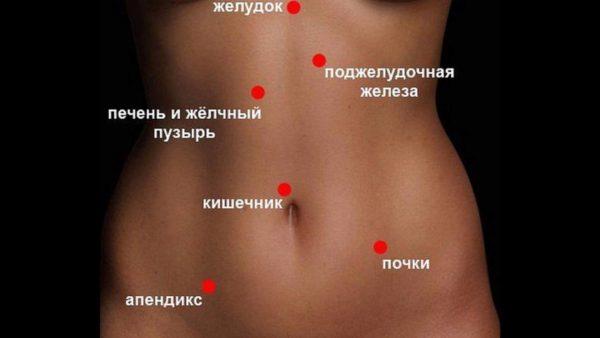
This part of the abdomen is occupied by the stomach, kidney fragment, spleen, intestines and pancreas
Table 1. Pain sensations
| Features of pain | Description |
| Stabbing | Occurs with excessive physical exertion. Long runs or jumping, for example, can trigger a short-term attack, especially if the exercise is done immediately after a large meal. |
| cutting | If the attack was not preceded by vigorous activity, the following diseases are suspected: • myocardial infarction; • splenic rupture; • acute form of pancreatitis. |
| Acute | After serious injuries to the abdominal area, discomfort sometimes appears during active inhalation. This indicates injury to internal organs. |
| Dumb | If an attack lasts more than 1 day, there is a high probability of having chronic diseases of the gastrointestinal tract. An enlarged spleen caused by autoimmune pathologies and bacterial infections also occurs with muted pain. |
| Aching | Mild pain can be an alarming sign of colitis or duodenitis. In combination with attacks of nausea or vomiting, it is sometimes diagnosed as a stomach ulcer. Often such symptoms indicate the development of coronary heart disease. |
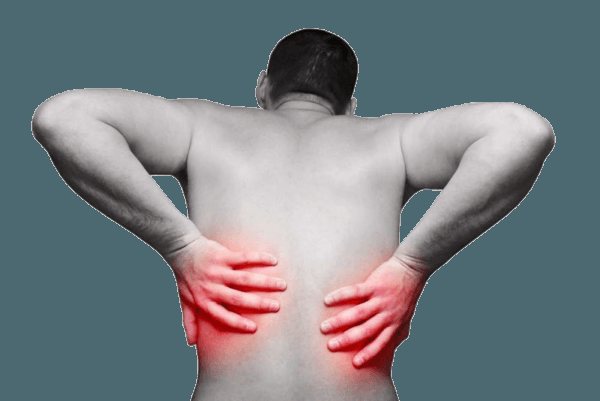
Pain can vary in nature
Summarizing the above factors, painful sensations can be triggered by the following ailments:
- heart attack;
- pleurisy;
- splenic rupture;
- tumors of the gastrointestinal tract;
- dysfunction of the heart muscle;
- duodenitis;
- intercostal neuralgia;
- splenomegaly;
- diaphragmatic hernia.
In general, any diseases of the “representatives” of the digestive system, localized in the left part of the peritoneum, can provoke a painful attack.
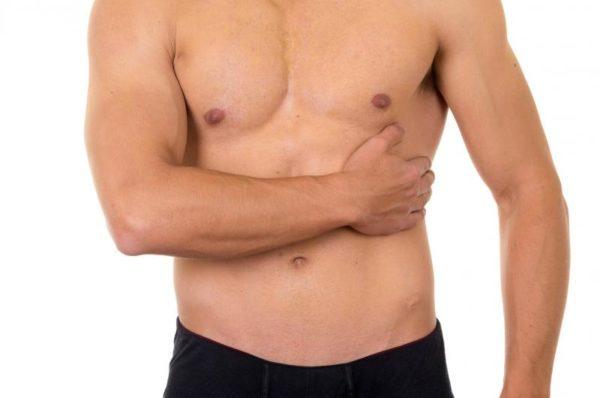
Pain in the abdominal area differs in the mechanism of its occurrence
A good diagnostic source is a detailed description of the pain pattern, starting from the moment of its onset:
- Reflected. It appears as an echo of painful sensations coming from organs adjacent to this area, such as during pneumonia.
- Visceral. Accompanies intestinal spasms and disruptions in the motor functions of the stomach. With increased gas formation, it can spread from the left to the right hypochondrium.
- Peritoneal. The source of occurrence is easily determined. The pain is caused by irritation of the abdominal area. Observed during exacerbation of stomach ulcers.
Note. If pain slowly moves from the left side of the abdomen to the navel, doctors diagnose diseases of the duodenum.
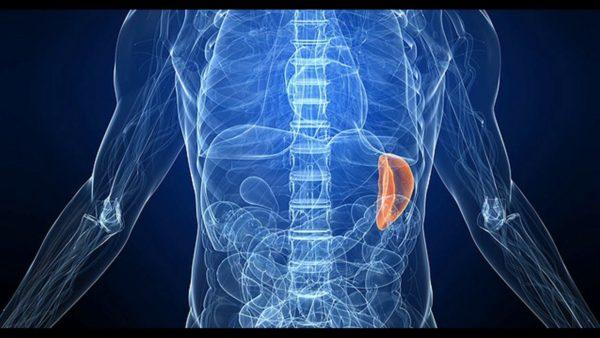
Diseases of the spleen often manifest themselves through discomfort in the left hypochondrium
What can hurt?
Pain on the left side under the heart usually does not indicate problems in the functioning of the heart, but indicates diseases of the internal organs listed above. Also, discomfort and pain on the left appears with injuries to the spine and ribs. Osteochondrosis leads to the development of neuralgia, in which pain is localized on the left in the hypochondrium.
Heart diseases
Pain under the heart on the left side, localized in the front, is not a direct indicator of a disease of this organ. Pain in the heart is felt by a person as pain in the center of the chest, and at the same time the pain syndrome can radiate to the left side - arm, shoulder, neck, jaw. But actual pain under the heart is not the same thing as pain in the heart, and most often it indicates a problem in another organ.
The most common diagnosis accompanied by severe chest pain associated with the heart is a heart attack, but it is felt precisely in the center of the chest from the front or back. In some cases, a sharp burning pain under the heart on the front left may be a symptom of an atypical case of coronary artery disease.
Coronary heart disease (CHD) is another common cause of chest pain. Angina pectoris can cause a burning sensation in the central chest area during physical or psycho-emotional stress. In this case, there may be a kickback under the shoulder blade or left arm. The attack lasts from 1 to 10 minutes (occasionally lasts up to 30 minutes) and goes away after stopping stress or using nitroglycerin.
Enlargement and diseases of the spleen
Pain in the left hypochondrium under the heart, felt under the lower rib, aching or dull in nature, often occurs with various pathologies of the spleen. It is located close enough to the surface of the body, being vulnerable to mechanical damage.
Blows, bruises, and falls can cause organ rupture. In this case, the pain on the left under the ribs will be more intense and acute.
Hemoblastic diseases also cause organ enlargement, such as:
With tuberculosis, malaria, lupus and other diseases, the spleen also tends to enlarge. The spleen itself can become inflamed, which will lead to more intense pain under the heart on the left. If you experience such sensations, you should seek medical help.
Diseases of the stomach and gastrointestinal tract
Various pathologies of the stomach and gastrointestinal tract can also cause pain in the left side under the heart. Discomfortable sensations in the epigastrium on the left are perceived as burning, aching or cutting pain when:
- gastritis - inflammation of the gastric mucosa;
- ulcer - violation of the integrity of the mucous membrane;
- malignant neoplasms.
Depending on the severity of the disease, sensations may occur with:
- belching with a sour or putrid odor;
- vomiting, which brings relief;
- diarrhea.
Low acidity with gastritis usually causes pain on the left or in the center of the epigastrium immediately after eating, while high acidity occurs with pain during long breaks between meals (the so-called “hunger pains”).
Peptic ulcer disease is in many ways similar to gastritis in terms of symptoms, the main difference is the nature and intensity of pain on the left under the ribs: they can occur regardless of food and have a more pronounced acute nature.
Pathologies of the pancreas
Pancreatitis is accompanied by nagging pain surrounding the abdominal cavity, which can also be felt as pain under the heart on the left side. Often, unpleasant sensations begin after fatty, too sweet, fried foods, alcohol and are accompanied by symptoms such as:
Why does it hurt on the left side under the ribs in front?
Centuries-old medical practice has succeeded in identifying internal pathologies. Women experience pain on the left side during exacerbation of endometriosis. The affected tissues, when swollen, provoke the occurrence of prolonged nagging pain that fills the peritoneum.
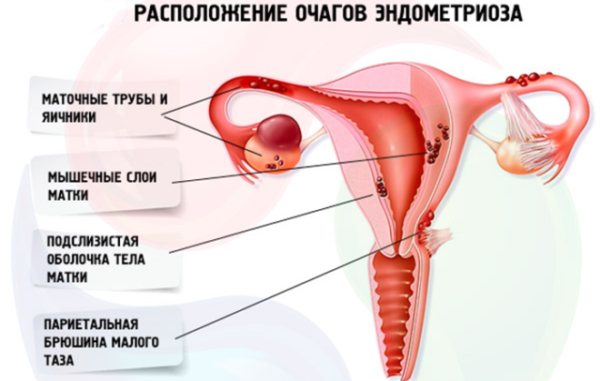
Location of endometriosis foci
Cracks and fractures of the ribs also lead to severe pain in the left hypochondrium. Numerous fractures pose a danger to organs located adjacent to the sternum and cause severe damage to the body.
Among the many diseases localized in this zone, the most typical and common ones can be identified.
Pathologies of the diaphragm
The opening in the thoraco-abdominal barrier, intended for the esophagus, serves as the border zone between the thoracic and abdominal cavities. If the muscular frame weakens, the lumen becomes larger, which is fraught with movement of the upper part of the stomach from the peritoneum to the sternum. At the same time, the “filling” of the stomach begins to be released into the esophagus.
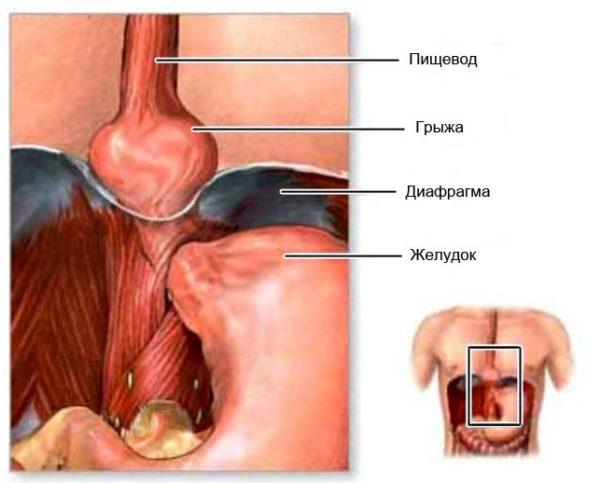
Factors that enhance the formation of a hernia:
- bearing a fetus;
- decreased muscle tone;
- excess weight;
- excessive loads.
Often this condition leads to pinching of the stomach, accompanied by acute, cutting pain.
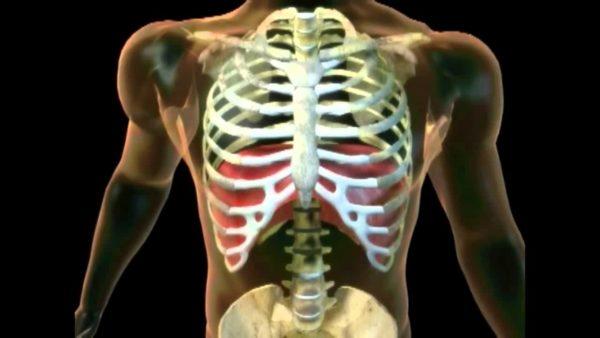
Discomfort in the left side of the peritoneum may be a harbinger of a diaphragmatic hernia
Intercostal neuralgia
Many neurological pathologies can lead to irritation of the nerves located between the ribs. Painful sensations are characterized by a wide range of manifestations - from weak and aching to cutting. When coughing, sharp sighs or changing body position, the pain intensifies.
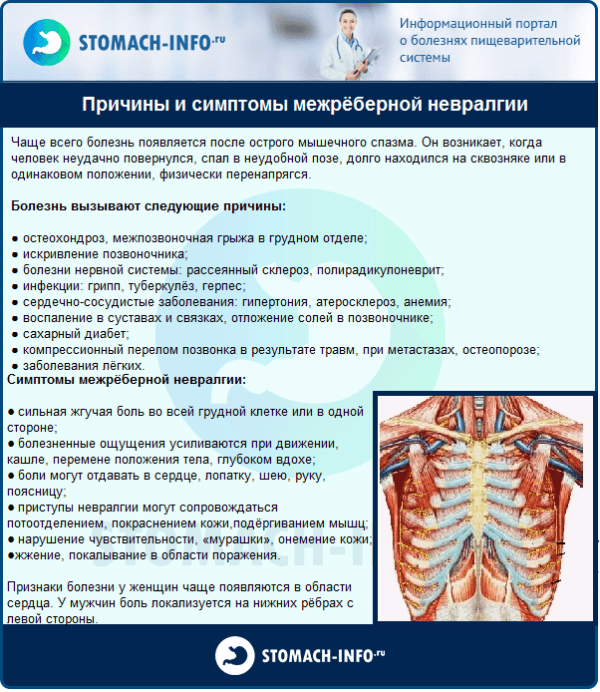
Causes and symptoms of intercostal neuralgia
The attacks are severe: a stabbing pain arises in the sternum, radiating to the left side, the muscles spasm and sweating increases. When you press on the spine area, severe pain occurs.
During neuralgia, pain covers the entire lumbar region and the area under the shoulder blades. The pain lasts for a long period of time and often leads to numbness in certain areas of the body.
Heart pathologies
Despite the fact that the left part of the peritoneum is attached to the organs of the digestive system, diseases of the internal motor are also expressed through discomfort in this area.
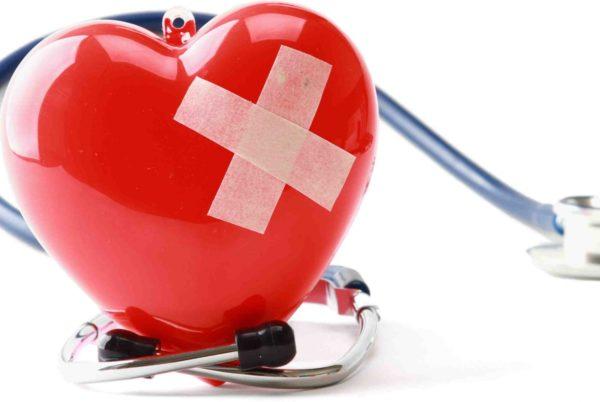
Heart disease tends to manifest itself through pain in the left hypochondrium
For example, the following symptoms are typical for coronary heart disease:
- aching, weak pain;
- constant shortness of breath;
- cardiopalmus;
- nausea;
- burning sensation in the chest area.
Ischemia is caused by pathologies of the arteries, leading to a deterioration in the blood supply to the heart.
Also, similar symptoms are observed with cardiomyopathy, characterized by dysfunction of the heart muscle. It is accompanied by severe asthenia and acute pain during any active actions.
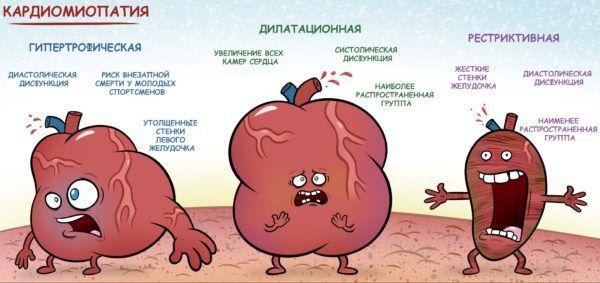
The gastralgic form of myocardial infarction in 3% of situations manifests itself through pain in the left side of the abdomen. Patients note uncomfortable, bursting sensations in the sternum, increased sweating, diarrhea and nausea, turning into vomiting. Such symptoms often mislead specialists when making a diagnosis, since they are similar to the manifestations of digestive disorders. Difficulty breathing, blue lips and swelling of the face indicate the presence of heart problems.
Treatment methods
Diagnostics involves the use of a wide variety of instrumental and laboratory tests:
- X-ray;
- blood and urine tests;
- Ultrasound of internal organs;
- CT;
- MRI.
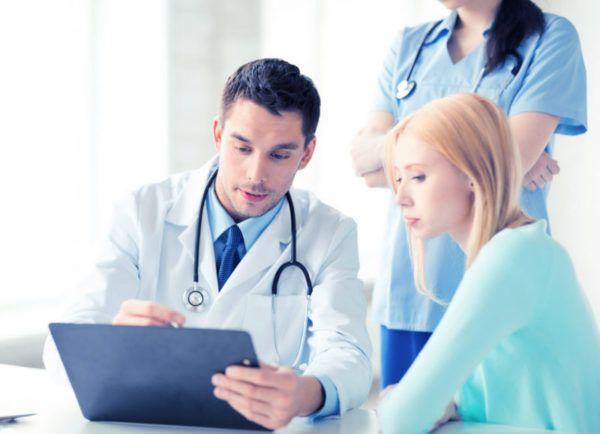
You need to see a doctor and not self-diagnose
Depending on the complaints and examination results, the patient is scheduled for a consultation with a specialist doctor - a gastroenterologist, cardiologist, surgeon, traumatologist and endocrinologist.
To relieve painful sensations and eliminate the disease that provoked them, specialists use the following methods.
Table 3. Methods for relieving and eliminating painful sensations
| Method | Description |
| Manual therapy | Reduces inflammatory processes and accelerates tissue regeneration. |
| Reflexology | Includes many techniques - heat therapy, acupuncture and acupuncture. Effectively relieves pain and relaxes. |
| Physiotherapy | It is used as an additional method to the main therapy. Increases blood circulation, successfully fights swelling and inflammatory processes, eliminates disorders of the musculoskeletal system. |
| Massotherapy | Removes muscle spasms and stimulates the circulatory system in problem areas. |
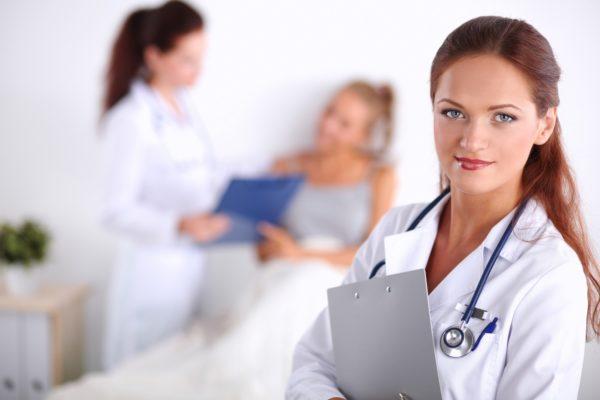
Do not self-medicate, but consult a specialist
If severe discomfort occurs in the area of the left hypochondrium, and pain appears at regular intervals, you should immediately consult a doctor. Self-diagnosis and treatment not coordinated with a specialist can lead to negative consequences for the body. Timely initiation of therapy will help prevent diseases from becoming chronic and maintain health.
Video - Pain and heaviness in the left hypochondrium
Many people experience pain on the left side under the ribs. This common symptom does not occur on its own, but is always a consequence of some pathological process in the body or a simple deviation from the physiological norm. The nature of the pain, duration, severity, and accompanying symptoms depend on the underlying cause. Familiarize yourself with the main factors in the development of pain in the hypochondrium, the principles of their diagnosis, prevention and treatment.
What hurts on your left side? What are the dangers of pancreatic problems?
It happens that the left side begins to hurt after eating, during running or other physical activity, and sometimes discomfort and painful sensations do not depend on food intake or physical activity. Pain of this kind can be both the body’s reaction to natural processes and a signal of the onset or exacerbation of diseases of the internal organs. The nature of the pain can be different, it depends on the reasons why the painful spasm occurs. Our article will help you figure out why it hurts under the ribs, what to do and which doctor to go to. The abdominal cavity contains many vital organs, so if you experience severe, periodically disturbing, and even more so persistent acute pain, you should immediately, without delay, consult your doctor. In order to diagnose at the initial stage why pain occurs, a person must describe its nature, of course, with a certain degree of subjectivity. Depending on what kind of pain in the left side, where exactly it is localized, where it goes, you can guess what its cause is, what it really hurts. The doctor will make the final diagnosis based on additional examination, which will most likely be needed. You can get diagnostics at a discount using promotional offers on the Coupon.
.
What is pain on the left under the ribs?
Painful sensations localized on the left in the region of the ribs and under them are not specific. They can signal diseases of internal organs and the nervous system. When diagnosing, their precise localization and determination of their nature can help to detect and differentiate serious systemic pathologies (oncological diseases, injuries, chronic inflammatory processes). Pain under the ribs can be dull, sharp, pulling or throbbing, accompanied by other symptoms associated with the underlying disease:
- dyspeptic manifestations;
- dizziness;
- general weakness;
- loss of consciousness;
- pale skin;
- rise in body temperature;
- chills, etc.
Why does my left side hurt under my ribs?
You should not ignore the pain and burning sensation in the left side, even if these unpleasant symptoms have passed completely, because may indicate serious pathologies that require treatment. The following causes of pain occur:
- diseases of the gastrointestinal tract;
- systemic lupus erythematosus;
- lymphomas;
- malaria;
- inflammation of the visceral peritoneum;
- perforation (hole) in hollow organs;
- chronic myeloid leukemia;
- kidney infections;
- distension of the renal pelvis;
- diaphragmatic hernia;
- cholecystitis;
- cholelithiasis;
- thoracic intercostal neuralgia;
- ischemic colitis;
- splenitis, splenomegaly, splenic rupture;
- vegetative crises;
- myocardial infarction, pericarditis, angina pectoris;
- compression of organs during pregnancy.
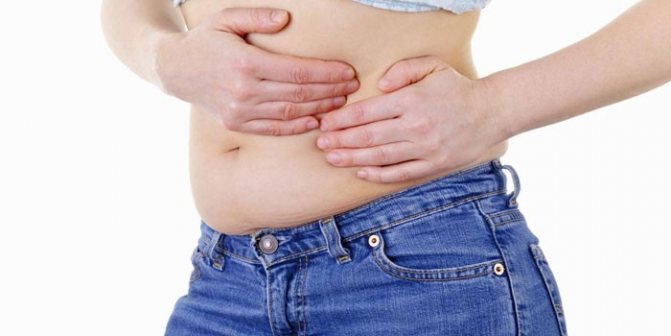
Front
Pain on the left under the ribs in front is provoked by chronic sluggish inflammatory diseases of the gastrointestinal tract. At the same time, unpleasant sensations occur regularly and last a long time. A strong burning sensation in most cases indicates chronic pancreatitis. If the pain in the front is constant and intensifies after eating, then this may indicate gastroduodenitis, sometimes the presence of a tumor.
Side
Most doctors associate pain in the left hypochondrium with pathological disorders of the functioning of the heart. This syndrome can also signal other diseases: intercostal neuralgia, acute renal failure, significant enlargement of the spleen. There is no clear reason that will help immediately determine the main diagnosis based on the location of the pain, so pain under the left rib requires consultation with a specialist.
Video: pain in left side when running
Want to know why you get rib pain when running? Watch a video by a professional athlete and coach, which talks about the traditional point of view on this problem and the author’s vision of it, based on personal experience. How is this related to the general physical condition of a person, the load on the breathing apparatus, and the work of the diaphragm. You will learn what you should do so that when you walk fast, run, and do other dynamic loads, you are not bothered by unpleasant sensations in your left side.
Perhaps most people, at least once in their lives, have experienced pain or other unpleasant sensations behind the sternum or to the left of it in the chest, exactly where the heart is located. These pains attract attention and cause concern more than many others - this is how we instinctively react to “problems” in the location of such an important organ. It is not for nothing that pain in the heart area is the most common reason for seeking medical help. Characteristic pain in the left side of the chest occurs with myocarditis and pericarditis. Most often, pain in the heart area occurs with the so-called stage 3 hypertension, when increased blood pressure and impaired blood flow lead to severe disorders of the heart and other organs.
Pain in the heart area, that is, in the left or central side of the sternum, can be for a variety of reasons. Conventionally, all chest pain can be divided into cardiological and non-cardiological.
Pain in this area varies. They prick, press, squeeze, bake, burn, whine, pull, pierce. They can be felt in a small area or spread throughout the chest, radiating to the shoulder, arm, neck, lower jaw, stomach, under the shoulder blade. They can appear for a few minutes or last for hours, or even days on end, and can change with breathing, moving the arms and shoulder girdle, or changing posture. Sometimes they occur during physical or emotional stress, sometimes at rest or in connection with eating.
There are many causes of pain in the heart area. They can be heart diseases such as angina pectoris, myocardial infarction, inflammation of the heart and its membranes, and rheumatic lesions. But often the source of pain is outside the heart, as, for example, with neurosis, diseases of the ribs and thoracic spine, problems with the gastrointestinal tract and many other diseases.
Why does my heart hurt?
Heart pain is one of the most common reasons people seek emergency care. Heart pain can be divided into two main groups according to its origin:
- anginal pain that occurs at various stages of coronary artery disease;
- cardialgia caused by inflammatory heart diseases, congenital diseases and heart defects or vegetative-vascular dystonia.
Diagnostics
If you regularly feel pain or tingling in the left side under the ribs, you should seek help from a physician at the clinic, who will conduct a general examination and prescribe laboratory and instrumental tests:
- X-ray;
- ultrasound diagnostics;
- general blood analysis;
- blood chemistry;
- computed tomography.
The results of the examination will help to identify the immediate cause of pain in the side and determine further treatment tactics. Additionally, consultation with more specialized specialists may be required: traumatologist, surgeon, infectious disease specialist, gastroenterologist, oncologist, etc. If acute pain suddenly occurs in the left side under the ribs, you should immediately seek help in a hospital, because the symptom may be caused by rupture or perforation of an organ, bleeding, or other condition requiring immediate medical attention.
The pain is not of a pathological nature
There are situations when pain in the left hypochondrium appears in a patient who does not suffer from any diseases. This happens due to:
- excessive physical activity;
- sudden body movements;
- unbalanced nutrition and its consequences.
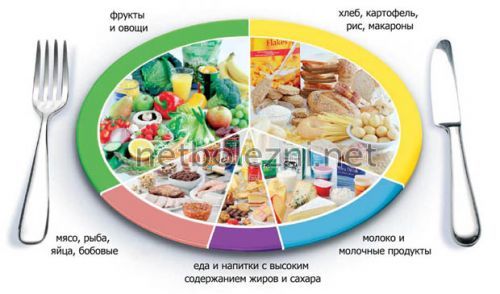
Pain of this etiology does not require therapy. However, it is worth paying attention to eliminating such influencing factors.
Pain under the ribs in the left side occurs in acute and chronic diseases of internal organs, nerves, and muscles. In the projection of the left hypochondrium are the spleen, the left flexure of the colon, the fundus of the stomach, the tail of the pancreas, the left part of the dome of the diaphragm, intercostal nerves, the lower lobe of the left lung and the pleura. The nature of the pain syndrome helps to distinguish one disease from another, prescribe a diagnostic examination and determine treatment tactics.
The left side hurts under the ribs on the side, what could it be? We will discuss it in this material.
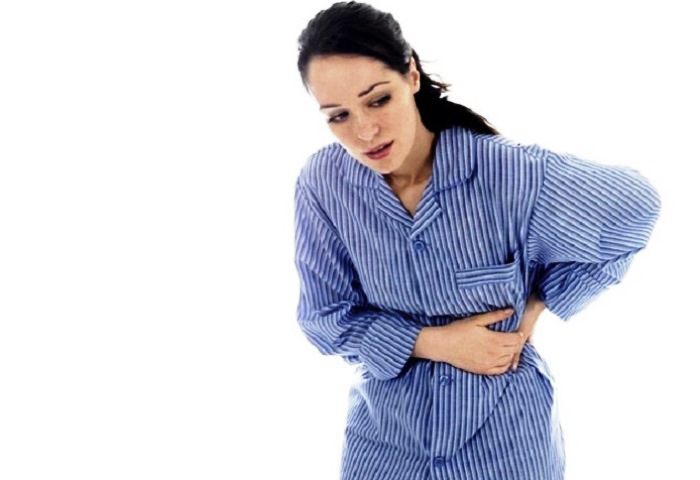
Treatment
To eliminate pain under the ribs, you need to take a horizontal position, relax, open the window and remove constrictive clothing. Some medications will help stop the attack:
- antispasmodics (Drotaverine, No-Shpa);
- anti-inflammatory drugs (Ibuprofen, Nurofen);
- analgesics (Analgin).
Remember that in case of severe sudden pain, accompanied by vomiting, nausea, dizziness, pallor, fever, you must immediately seek help from specialists. In some cases, emergency surgery is indicated to eliminate the cause of the pain syndrome. Indications for surgical intervention may include:
- organ rupture;
- peritonitis;
- appendicitis;
- ulcer perforation;
- internal bleeding of any etiology.
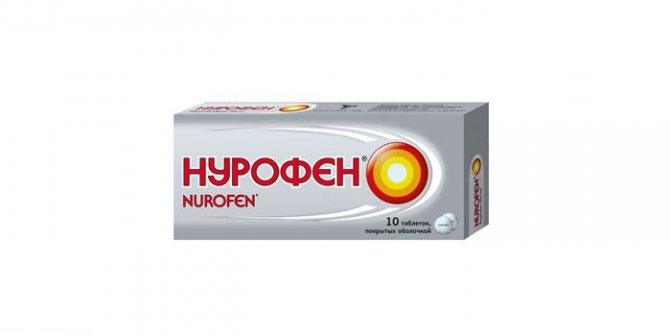
Prevention
A painful symptom under the ribs is one of the first signs of a developing serious disease. These may be circulatory disorders of organs, inflammatory processes, neoplasms, etc. In order for pain under the left rib and its main cause not to lead to serious conditions, several recommendations must be followed:
- periodically undergo a full medical examination;
- in the presence of chronic pathologies, adhere to the doctor’s recommendations;
- at the first signs of pain, immediately consult a doctor;
- avoid injury.
Possible manifestations of pain
You can identify the cause of discomfort on the left under the ribs only by analyzing its nature and additional symptoms. Based on the form of manifestation, the following types of pain are distinguished:
- Constant or episodic.
- Sharp and harsh or dull and aching.
- Increasing or not changing intensity.
- Local or extending into the neck, shoulder, shoulder blade.
Pain under the left lower rib or above is dangerous when added to it:
- dyspnea;
- pale skin;
- vomit;
- fever;
- fainting.
